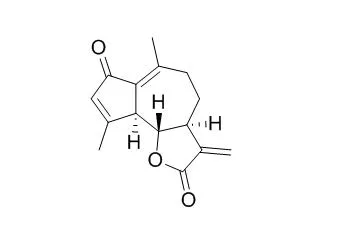| Kinase Assay: |
| Anticancer Agents Med Chem. 2017;17(6):839-850. | | Dehydroleucodine Induces a TP73-dependent Transcriptional Regulation of Multiple Cell Death Target Genes in Human Glioblastoma Cells.[Pubmed: 27671304 ] | Dehydroleucodine, a natural sesquiterpene lactone from Artemisia douglassiana Besser (Argentine) and Gynoxys verrucosa (Ecuador).
To define the molecular mechanisms underlying the effect of Dehydroleucodine on the human glioblastoma cells.
METHODS AND RESULTS:
Various techniques (cDNA expression array, real-time quantitative PCR, chromatin immunprecipitation, luciferase reporter assay, use of phosphospecific antibodies, immunoprecipitation, immunoblotting, apoptosis and autophagy assays) were employed to define and validate multiple molecular gene targets affected in human glioblastoma cells upon Dehydroleucodine exposure.
Dehydroleucodine exposure upregulated the total and phosphorylated (p-Y99) levels of TP73 in U87- MG glioblastoma cells. We found that TP73 silencing led to a partial rescue of U87-MG cells from the cell death induced by Dehydroleucodine. Upon the Dehydroleucodine exposure numerous gene targets were upregulated and downregulated through a TP73-dependent transcriptional mechanism. Some of these gene targets are known to be involved in cell cycle arrest, apoptosis, autophagy and necroptosis. Dehydroleucodine induced the TP73 binding to the specific genes promoters (CDKN1A, BAX, TP53AIP1, CYLD, RIPK1, and APG5L). Moreover, the exposure of U87-MG cells to Dehydroleucodine upregulated the protein levels of CDKN1A, BAX, TP53AIP1, CYLD, RIPK1, APG5L, and downregulated the CASP8 level. The formation of RIPK1 protein complexes and phosphorylation of MLKL were induced by Dehydroleucodine supporting the notion of multiple cell death mechanisms implicated in the tumor cell response to Dehydroleucodine.
CONCLUSIONS:
This multifaceted study led to a conclusion that Dehydroleucodine induces the phosphorylation of tumor protein TP73 and in turn activates numerous TP73-target genes regulating apoptosis, autophagy and necroptosis in human glioblastoma cells. | | Eur J Pharmacol. 2011 Dec 5;671(1-3):18-25. | | The effect of dehydroleucodine in adipocyte differentiation.[Pubmed: 21963454 ] | Dehydroleucodine (DhL) is a sesquiterpene lactone of the guaianolide group with gastric cytoprotective activity. Recent studies have also demonstrated that DhL inhibits the proliferation of vascular smooth muscle cells.
METHODS AND RESULTS:
In this study we examined the effect of DhL in the differentiation of 3T3-L1 preadipocytes. The addition of DhL significantly inhibited the differentiation of 3T3-L1 preadipocytes along with a significant decrease in the accumulation of lipid content by a dramatic downregulation of the expression of adipogenic-specific transcriptional factors PPARγ and C-EBPα. However, phosphorylation of AMPKα, Erk1/2 and Akt1 was not inhibited by DhL treatment. Interestingly, we also found that 11,13-dihydroDehydroleucodine, a derivative of DhL with inactivated α-methylene-γ-lactone function, also inhibited the differentiation of 3T3-L1 preadipocytes.
CONCLUSIONS:
Taken together, these data suggest that DhL has an important inhibitory effect in cellular pathways regulating adipocyte differentiation by modulating the PPARγ expression, which is known to play a pivotal role during adipogenesis. |
|
| Cell Research: |
| Cell Mol Biol (Noisy-le-grand). 2005 Nov 8;51(6):525-30. | | Dehydroleucodine inhibits vascular smooth muscle cell proliferation in G2 phase.[Pubmed: 16309576] | Vascular smooth muscle cell (VSMC) proliferation plays an important role in the development of atherosclerosis and in the vascular changes seen in hypertension. Dehydroleucodine (DhL) is a sesquiterpene lactone that inhibits cell proliferation in plant cells.
METHODS AND RESULTS:
In this paper, we study the effect of DhL in the proliferation of VSMCs stimulated with 10% fetal bovine serum (FBS). Very low concentrations of DhL (2-6 microM) inhibited VSMC proliferation and induced cell accumulation in G2. DhL did not affect the dynamics of 3H-thymidine incorporation, and did not modify either the activity of DNA polymerase or the incorporation of deoxyribonucleotides in an in vitro assay. Moreover, DhL did not induce apoptosis in VSMCs. These results indicate that DhL, in very low concentration, induces a transient arrest of VSMCs in G2.
CONCLUSIONS:
Our data show that VSMCs are especially sensitive to DhL effect, suggesting that DhL could be potentially useful to prevent the vascular pathological changes seen in hypertension and other vascular diseases. |
|






 Cell. 2018 Jan 11;172(1-2):249-261.e12. doi: 10.1016/j.cell.2017.12.019.IF=36.216(2019)
Cell. 2018 Jan 11;172(1-2):249-261.e12. doi: 10.1016/j.cell.2017.12.019.IF=36.216(2019) Cell Metab. 2020 Mar 3;31(3):534-548.e5. doi: 10.1016/j.cmet.2020.01.002.IF=22.415(2019)
Cell Metab. 2020 Mar 3;31(3):534-548.e5. doi: 10.1016/j.cmet.2020.01.002.IF=22.415(2019) Mol Cell. 2017 Nov 16;68(4):673-685.e6. doi: 10.1016/j.molcel.2017.10.022.IF=14.548(2019)
Mol Cell. 2017 Nov 16;68(4):673-685.e6. doi: 10.1016/j.molcel.2017.10.022.IF=14.548(2019)